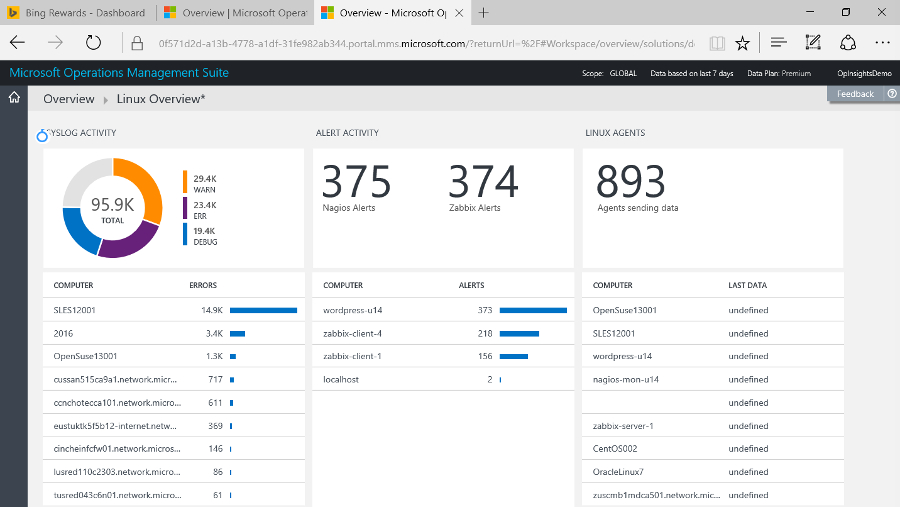How Microsoft is serious about supporting Linux and cloud rivals with OMS
New Microsoft, new attitude…

When Microsoft first announced its new Operations Management Suite (OMS) cloud monitoring service last May, it wasn't the case that handling Linux systems was an afterthought, but the tools certainly didn't have parity with what you could do for Windows Server.
At the time, Jeremy Winter, who runs the OMS team, talked about Linux as being "on our roadmap to come" with the first option being deploying Microsoft's own management agent into a Linux VM – which could be on AWS or VMware, not just Windows Server or Azure.
In the old Microsoft days, things might have stayed at that level, like a cloud version of the System Center approach. But the way Microsoft approaches cross-platform is rather different now and even veterans of System Center like Robert Reynolds understand that Microsoft needs to fit in with the existing Linux ecosystem, and that's why the Linux agent for OMS is now a plugin to the popular Fluentd, even though Microsoft had originally experimented with an agent for the Linux systemd service manager.
Working with the community
"When we started the preview, we had our own management agents," Reynolds explains, "but the Linux community said to us 'we already have agents deployed, there's already an open agent infrastructure'. So we worked with the community to find out which agent they preferred, which one they thought would be the long-term choice and the majority of people we're working with have adopted Fluentd, so we went with that."
And in a move that would have once been unusual but is quickly becoming 'business as usual' at Microsoft, the OMS plugin for Fluentd is being open sourced. "We're Microsoft, so there's scepticism," admits Reynolds. "We're going to earn it. Part of earning that support and trust in the Linux community is being part of it, so that's how we're making decisions for Linux support and how we're delivering them."
There's already support for connecting to existing open source monitoring services like Nagios and Zabbix from OMS. "We have the ability to plug in to those existing data streams. So instead of having to go replace an entire infrastructure or technology that's already there, things like Nagios and Zabbix we can immediately connect to and start to pump the data in from."
The OMS team has also started working on allowing customers to create custom logs and environments – that work will continue through the next year, he says. But the willingness to work with the Linux community has already led to what he calls "steady growth – 10% and more a month – in on-boarding Linux machines" since the Fluentd plugin came out last October.
Are you a pro? Subscribe to our newsletter
Sign up to the TechRadar Pro newsletter to get all the top news, opinion, features and guidance your business needs to succeed!
Supporting rivals
There's the same commitment to supporting VMware and rival clouds like AWS and OpenStack. "With our backup service in OMS, we support VMware backups, so machines running on VMware can be backed up from one VMware environment to another VMware environment that's running on-premises, and we managed to simplify a lot of the technology that's needed there.
"That also allows us to do VMware to Azure to give you failover sites. And we did RedHat support so that you can have VMware and RedHat instances that are being protected to Azure."
The same approach applies to managing virtual machines, wherever they are. "There are two ways to think about a bunch of VMs," he points out. "We can go and put agents in them, but the other option is that the platform itself will provide some monitoring and manageability and we can plug into that instead. In AWS, for example, that's CloudWatch, and over time we'll connect to those APIs and be able to collect data and analyse that."
For alerts, you can already use a webhook to send an OMS alert to a range of services. "You can just cut and paste the webhook URL from PagerDuty, Zendesk, Slack; anything that supports webhook. And that's a big, big list."
"The notion of making sure that it's truly on any operating system is key," says Reynolds. "If you want to get the 100% view, at the right level of fidelity, into your environment, this is where we're bringing all this data together."
- 1
- 2
Current page: Introduction and working with the community
Next Page On-demand development and the next stageMary (Twitter, Google+, website) started her career at Future Publishing, saw the AOL meltdown first hand the first time around when she ran the AOL UK computing channel, and she's been a freelance tech writer for over a decade. She's used every version of Windows and Office released, and every smartphone too, but she's still looking for the perfect tablet. Yes, she really does have USB earrings.
Most Popular

